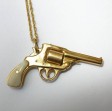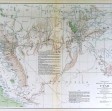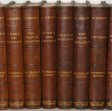Antique Cartridges Part 1 – From the Shanty
By: Dr. J (Photos by: George Warnick, aka Lone Gunman)
Editor’s Introduction: We will be publishing a continuing series on Antique cartridges by Dr. J. for some time to come. This first article is an introduction from Dr. J providing some insight into his expertise on historical items of interest, including the battle of the Big Horn. In the next article we will be covering the Paper and Skin Combustible .44 Caliber “Army” Colt Cartridge.
At times, it is difficult to introduce one’s self and to tell everyone what you want them to know about yourself. I was born in St. Louis, MO in 1940, a “half-breed” by bloodline with a keen interest in cartridges as early as 1944-45 while the Great War was going on. Dad was a Navy Commander, and he and his friends brought home ammunition samples and specimens for me. I was selling extras of those cartridges at shows as early as 1945, though I always managed to keep one of each for my collection. My father was a well-known funeral director in St. Louis by the name of Jay B. Smith, and he went hunting in Africa every year giving me “Big Bore British” ammunition specimens. In those years, a Spencer cartridge was worth 25 cents, a .54 Burnside could be bought with a 50-cent piece, and a .600 Nitro could cost as much as $4.00.
I was not going to collect a “reload” or altered cartridge of any form; factory originals were what I wanted. Headstamps could even be the same if a different primer or a bullet variation was found. It did not take a very long time to discover endless variations of bullets, primers, cases, and headstamps in the same caliber. An empty case was okay until a better specimen was found. I soon had a line-up of shotshells that were all alike but all with different shot sizes marked on the top wad. At the tender age of seven, Mother found me in the basement due to a new smell in the house. I had a ruler taped to the wall and had discovered the flame height was different in a green Remington 12-gauge shell than in a measured thimble-full of powder from a red-paper Winchester 12-gauge shotshell, and still a different height from a Federal shotshell. Mom let me know before bed I’d be killed by Dad due to my trying to “burn the whole house down.”
Dad and I had a talk about gunpowder, and how each had its own burning rate. He knew of black powder from the big navy guns and went on to tell me about it having the same burn rate inside of a gun, as it also would have when laying out on the open ground. He went on to say that all of the early shotshells (and other early ammo) were loaded with this very volatile black powder. He clearly did not wish me to get hurt. I was to be careful and not get hurt by any more “flame testing” or cutting into ammunition I knew nothing about. He suggested that I check with him first. From this point on, the “tests” came to Dad’s attention, or supervision, or we’d wait until we had a better idea of what we were doing. Smokeless powder was a fairly safe item until it was inside a closed-up chamber. Dad had friends he knew in law enforcement and a crime lab that I could make calls to. In those years they did not just come to the house and take ammo from you. They knew I was a cartridge collector and was very serious about it, so they took the time to provide me with detailed answers.
Powders of unknown origin were dealt with by using a longer fuse to light them. Firecracker fuse in Missouri was available all year long. Soon, the crime labs were giving me ammo specimens and I was giving them anything I had an extra of. Many times, I had to buy a whole box of ammo to get one for my collection, but having leftovers, the balance of the box was used to sell or to trade to another collector. In 1984, I was called by the U.S. National Park Service to help identify the last and largest of all the “digs” at the Little Bighorn Battlefield, a dig headed up by Dr. Doug Scott and Dick Harmon of Lincoln, Nebraska. The dig was done by a number of University students from all over the U.S.A. and had many other volunteers involved with the project.
I found it most interesting that a total of 117 different calibers were dug up. Oddly enough, the last I knew, Custer carried a new .44-40 Winchester Model ’73 and a pair of .44s that some folks say were of British origin, other records say French. But no cartridge cases were ever found, or the bullets from either of the calibers Custer used. It makes one wonder if he was “taken out” very early on. Some books indicate he was one of the very first killed.
It’s not my role here to debate or argue either way, but rather to introduce a study of the many calibers and cartridges of the early west. I also saw many .45-70 empty cases badly swollen from being fired in the chamber of .50-70 rifles the Indians had left over from the Civil War. The .45-70 ammunition was probably stolen or traded to the Indians. The recovered lead bullets only showed rifling marks on one side. The body of the .45-70 case was swollen larger than the rim due to firing it in the .50-70 size chamber. .44 Henry cartridge cases also out-numbered all the other calibers found from the dig. Dr. Doug Scott also said, “Many people think the Indians may have had over a thousand Henry rifles in use that day!” There were a lot of unfired cartridges that were dug up from being dropped in the heat of battle. I also saw flat and square lead that Dr. Scott said was from Indians hammering lead bullets into shot for the shotshells they used. Dr. Scott also told me that he had data and records from Fort Lincoln which showed that Custer may have shaved his head or cut his long hair very short before he left the Fort. It was (some think) three years later before the Indians knew that they had, indeed, killed “ole yellow hair.” This is debated, however, by the history books that tell us that Custer’s body was not cut up as almost all the others were. The Indians did know him and who he was by the number of the bodies found. I am only stating what I was told here.
I raised two children of my own as well as over 60 foster kids and worked most of my years with problem kids. In the early years, I worked with the “Scared Straight” program where kids were taken into the maximum-security prison to get to know the “cons.” One kid I recall the most, Bernie, had over 300 prior law violations. After six months of Scared Straight, he was never in court again, and today is a productive employee – – a changed life. I retired in April, 1996, but some of you may remember me from the many gun shows with up to ten tables of original ammo and over 4,000 different kinds of ammunition laid out in one display — none of it made after World War II. Most folks told me it was the largest display of old ammunition they had ever seen anywhere.
I am now done with shows and all I want to be doing is cutting firewood, fishing, and shooting. Most of my time is spent at what I call the “Shanty.” It took over a year to make it happen, but it is a steel grain bin made secure with all an ‘ol rifle shooter needs in life to have fun — an antique wood stove for cold months, a 26,000 BTU Air-conditioner for the summer heat, a cement shooting bench, a window to shoot from with the shortest range being 205 yards, a huge backstop at 520 yards, and plans for dirt to be moved this summer so I can shoot out to 1,200 yards, all from the same shooting bench. A full size iron buffalo sits waiting to be hung.
I own a three-digit serial number Shiloh-Sharps .45-.70, have over 58 die sets for reloading, and have bench rest guns made by Wally Hart of Nescopeck, PA. No more having to pack the car up to go shooting and drive 20 miles to discover I forgot the ammo! What I write about comes from the shanty’s desk, 57 years of books in front of me, and a fair size cartridge collection that’s never been shown to the general public. It now can be shown with the wizard-like camera skills of George “The Lone Gunman” Warnick, who is able to produce some very interesting material. All photo credit belongs to George alone.
I have always felt bad that the public never sees the “good stuff”; it’s out-of-sight in homes or locked up safe. Those who have it never show it for fear of loss. Most museums lack it as well, or they lack the data on it to ever display it in a proper manner or identify it correctly. This material remains in private collections and stays there forever, never to be seen and seldom ever available for resale. My hope now is to show it, present any data available, and have it available for study.
Many times over the years, I have been called an “expert” and have never felt comfortable with the term or such a title. “Dr. Jay” was bad enough. It came from years of shooting, the gun show years, and the ability to provide a few answers to the questions that some folks asked of me. Fact is, I do not think there is such a thing as a person that has all the answers to every question he or she is asked. Nobody has all of the cartridges ever made either, or the many answers for them. I wish to make it very clear that I am only a “student” and learning (like you) each day if I pay attention! The best example I can recall took place a few years ago when a 10-year-old came to me at a show with his entire cartridge collection inside a cigar box. This kid had a couple of specimens in the box I had looked all my life to find, but had never seen in other collections. He had dug most of his collection out of a 25-cent junk box. One of his specimens was a .52 Sharps-Gardiner Explosive bullet of 1863 (Patent 40468) with a fuse nozzle projecting from its base. These bullets were made of pewter, not lead. It was a rare item worth $1,500 or more. Only one such item is known in all the rest of the world of cartridges. The kid bought it for 25 cents, the seller not having any clue as to what it was. I then told the young man what I knew of it and it’s in his collection to this day. I have given free ammunition to kids for many yeas to help and encourage the young collector, remembering how tough it was as a little kid to find different cartridge specimens for my collection. How else can we make a mark, for the very short time we are here, to provide care and safety to the few old cartridges left? In other terms, how can we pass on a piece of history and save it for the next generation?
One of the great mistakes many people make is to polish a cartridge. A real collector will have no interest in it when this has been done. Never put a cartridge into a drawer made of cedar or redwood, or have cartridges near these woods. The wood contains tannic acid and will either promote corrosion to the cartridge or more oxidation to the lead bullet. The old dry paper on old paper shotshells should never be touched due to moisture and oils in our skin. Many paper items need a plastic cover or zip lock bag, glass vile, or something to protect it like a old golf bag.
A good buddy of mine lost his finger when inserting a steel-case 20mm Vulcan round. He had drilled hundreds of brass-cased 20mm (live rounds) and had no trouble with it in the past. This time, however, the steel-case round sent static electricity to the powder and it blew up as the drill press drilled into the powder. To make a “cut-a-way” cartridge is very desirable, but it is very risky business, indeed, if you have no idea what you are doing. I will have more of this in future articles. That is enough for this introduction.
I am the fella on the left in the photo of the huge brass shell case. The guy on the right is a good friend, collector H. Rogers Hopkins of Crossville, Tennessee, and we were on our way to the Atlanta, Georgia arms show – a thousand-table show. The brass case weight is 135 pounds and was made in Germany in 1915. It stands 36″ inches tall and the inside mouth diameter is 16-1/4 inches. History says that the black powder charge was 600 lbs. and was stacked in wafer form past the case mouth up to the base of the 2200 lb. projectile. Each projectile was serial numbered and a bit larger in diameter to allow for wear to the bore. “Wanna put this into your shell belt?”
I do promise that all other cartridges I write about will be of smaller caliber than the one in the photo shown, but I thought it appropriate as an icebreaker for the introduction.
Lastly, I do welcome “feedback” and/or questions and while I don’t make claim to have the answers to what may be asked, I will do my best.
Editor’s Note: Questions may be sent in via e-mail to info@shootmagazine.com. Please include “Attn: Dr. J.” in the subject line.




